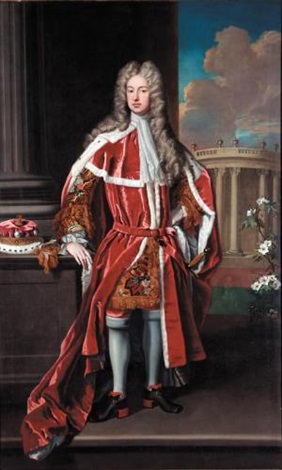Allen Bathurst, 1st Earl Bathurst facts for kids
Quick facts for kids
The Earl Bathurst
|
|
|---|---|
 |
|
| Captain of the Gentlemen Pensioners | |
| In office 1742–1744 |
|
| Preceded by | The Duke of Bolton |
| Succeeded by | The Lord Hobart |
| Personal details | |
| Born | 16 November 1684 |
| Died | 16 September 1775 (aged 90) |
| Spouse |
Catherine Apsley
(m. 1704) |
| Children | Henry Bathurst, 2nd Earl Bathurst |
| Parents | Sir Benjamin Bathurst Frances Apsley |
| Alma mater | Trinity College, Oxford |
Allen Bathurst, 1st Earl Bathurst (born November 16, 1684 – died September 16, 1775) was an important British politician. He was known as The Lord Bathurst for many years.
Bathurst was a member of the Tory political party. He served in the House of Commons and later in the British House of Lords. He was a key figure in British politics during the 1700s.
Contents
Who Was Allen Bathurst?
His Family and Early Life
Allen Bathurst was the oldest son of Sir Benjamin Bathurst and Frances Apsley. His family had lived in Sussex, England, for a very long time. He was born in St James's Square, Westminster, a famous area in London.
His father, Sir Benjamin, earned a lot of money. This wealth helped Allen and his two brothers get their own large estates. Allen inherited a place called Cirencester Park. He built the main house there between 1714 and 1718.
Allen Bathurst went to Trinity College, Oxford in 1700. He took over his father's estates in 1704. In the same year, he married his cousin, Catherine Apsley.
His Time in Parliament
Starting in the House of Commons
In 1705, Allen Bathurst was chosen to be a Member of Parliament for Cirencester. He was part of the Country Tory group. He was re-elected several times.
He was very active in the Tory government. In 1712, Queen Anne made him a Baron Bathurst. This meant he became a "peer" and moved from the House of Commons to the British House of Lords.
Moving to the House of Lords
As a strong Tory, Lord Bathurst often spoke out in the House of Lords. He was against Sir Robert Walpole, who was a very powerful Prime Minister. Bathurst was careful to stay away from secret political plots.
After Walpole left office, Bathurst became a Privy Councillor in 1742. This was a high honor. He also served as the Captain of the Honourable Corps of Gentlemen Pensioners from 1742 to 1744.
Later, he managed the money for Frederick, Prince of Wales. This was the son of King George II. The Prince and King had some disagreements. When Frederick's son, George III, became King in 1760, Bathurst received a yearly payment.
In 1772, 60 years after becoming a Baron, he was given an even higher title: Earl Bathurst.
Friends and Interests
A Friend to Artists
Lord Bathurst was not just a politician. He was also friends with many famous writers and thinkers of his time. These included poets like Alexander Pope and Jonathan Swift. Other friends were Matthew Prior, Laurence Sterne, and William Congreve.
In 1719, he helped start the Royal Academy of Music. This company brought operas to London. They hired famous composers like Handel to write music.
Bathurst also helped found the Foundling Hospital in 1739. This hospital cared for abandoned children. He is mentioned in letters by Laurence Sterne and in speeches by Edmund Burke. His letters with Alexander Pope were also published.
Later Years and Family
Lord Bathurst's wife, Catherine, passed away in 1768. He lived for another seven years, dying in September 1775 at the age of 90. He was buried in Cirencester church.
He and Catherine had four sons and five daughters. His son Henry became the 2nd Earl Bathurst after him. Henry had already been made Lord Apsley in 1771 when he became the Lord Chancellor.
His family also included Admiral Sir Thomas Pye (his nephew) and Henry Bathurst, who became a Bishop.

